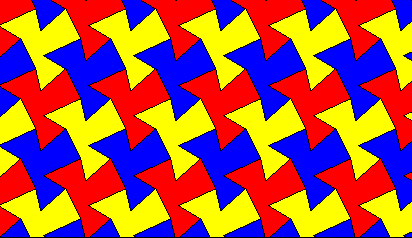

Specifically the regions of North Africa, Maghreb, and the Iberian Peninsula during the Middle Ages.

The finest examples of tessellation patterns in architecture and art can be found in Islam. Not only was the geometry of tessellation patterns fascinating to the tessellating artists, but intellectuals too began to show a deep interest in the mathematical structure of these tessellating patterns found from the Middle Ages and through the 19th century. Many of these designs have regional characteristics, which make them unique to the people and culture they originated from. Modern archeologists have uncovered many beautiful examples of tessellation art created by the Sumerian civilization, where it then spread to many other ancient civilizations such as the Romans, Chinese, Greek, Egyptians, Arabs, Moors, and Persians. The use of tessellation patterns in temples and homes can be traced back to sometime in 4,000 BC in Sumeria. Tessellation pattern of a street pavement in Zakopane, Poland Dmharvey, Public domain, via Wikimedia Commons This hints at the historical use of tessellation ideas that stretch far back into our history when small tiles made of glass, stone, or clay were used to create patterns on public and domestic surfaces. The word derives from the Latin word tessellātus (square small stones) and the Greek word tessera (four). The use of tessellation ideas and concepts throughout our history has resulted in the creation of beautifully decorated architecture, such as temples and mosques, as well as magnificent works of art.Īn understanding of ancient languages in history can help one better understand the tessellation definition. Also known as tiling, this process results in a mosaic pattern that can be used in a highly creative manner, despite its largely confining mathematical structure. What is Tessellation? Tessellation art is created through the process of covering a surface with a number of geometric shapes that fit together almost like a jig-saw puzzle, never overlapping and leaving no spaces between them.

(Remember that whatever details you add to one shape, will need to be added to EVERY shape! Keep your details simple.)ĩ. Trace over your pencil lines with a Sharpie and add details to each shape to help others recognize what you “saw” in it. Repeat this step until your whole paper is covered and there are no gaps or spaces.Ĩ. There shouldn’t be any gaps or overlapping. Now, pick up your tile and place it next to your traced design, as if it were a piece fitting into a jigsaw puzzle. (I use 12″x18″ paper when I do this with 6th graders.)Ħ. Place your tile on the center of a 9″x12″ paper and carefully trace around it. Lightly sketch your idea onto your tile…. Turn your newly created shape (we’ll call this your “tile”) in different directions and use your imagination to see if it “looks like” anything. (For older students, you can make this project more challenging by having them repeat this step on an adjacent side of their card, as in the sample project above.)Ĥ. If you include a corner in your cut, it makes it easier to line the shape up on the opposite side. Now, tape the shape so that it is exactly across from the spot you cut it from. (The lines on your index card will show you if you’ve flipped or turned it!)ģ. Next, cut a shape from one side of your 3″x3′ card, and slide it to the opposite side of the card, without flipping it over or turning it. Polygon – a shape with three or more sidesĢ. Tessellation – a pattern made with polygons that completely fills a space with no gaps, spaces or overlaps.

Escher – a Dutch artist (1898-1972) who is best known for his mathematically inspired drawings and prints which displayed great realism, while at the same time showing impossible perspective, eye trickery and metamorphosis.


 0 kommentar(er)
0 kommentar(er)
